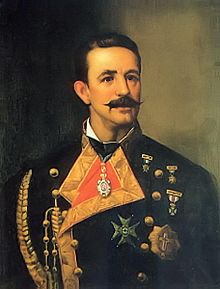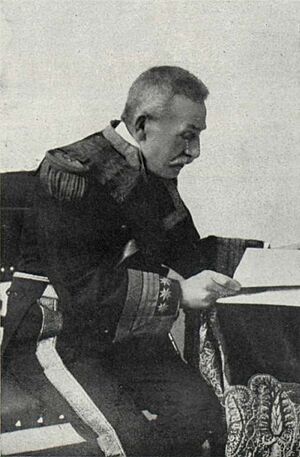Cesáreo Fernández Duro facts for kids
Quick facts for kids
Capitán
Cesáreo Fernández Duro
|
|
|---|---|

Fernández Duro as Capitán
|
|
| Born | February 25, 1830 |
| Died | June 5, 1908 (aged 78) |
| Resting place | Panteón de Marinos Ilustres, San Fernando, Cádiz |
| Signature | |
 |
|
Cesáreo Fernández Duro (born February 25, 1830 – died June 5, 1908) was an important Spanish naval officer, writer, and historian. He was known for his detailed books about the Spanish Navy and its history.
Contents
Early Life and Family
Cesáreo Fernández Duro was born in Zamora, Spain, into a noble family. His father, Francisco Fernández Torneros, was a lawyer. His mother was Teresa Ramona Duro. In Spain, people often use parts of both their parents' last names. So, Cesáreo's full last name, Fernández Duro, came from his father's name (Fernández) and his mother's name (Duro).
His family moved to Madrid, where Cesáreo received his early education. At that time, not many people in Spain could read and write. Going to school showed that his family was well-off and important.
At just 15 years old, in 1845, Cesáreo Fernández Duro joined the Naval School of San Fernando. This was the start of his exciting career at sea.
First Voyages and Bravery
In 1847, he became a midshipman on the ship Isabel II. He sailed in the Caribbean Sea for three years. Later, in 1851, he went to the Philippines on the Villa de Bilbao. There, he showed great courage during a battle near Joló Island. For his bravery, he received a special award called the Cross of the Order of San Fernando.
After returning to Spain, he worked with maps and sea charts in the Canary Islands. Even though he was young, he was made an honorary member of the Academy of Fine Arts in Santa Cruz de Tenerife.
Teaching and War Service
In 1853, he sailed the Mediterranean Sea on the Ferrolana. By 1857, he was teaching at the Naval College, where he wrote a textbook on Cosmography (the study of the universe).
In 1860, he commanded the steamer Ferrolano during the Hispano-Moroccan War. He wrote an important report about the port of Mogador. For his excellent service, he received another award and was promoted. He also served in the West Indies and Mexico, working as a secretary for naval operations. Later, he worked in the Ministry of the Navy in Madrid.
Historian and Scholar
After his active naval service, Fernández Duro became a respected scholar and historian. He was very interested in Spain's past.
Research and Royal Service
He helped organize trips to Ifni, a place in Morocco, to find an old Spanish settlement. He also did a lot of research on famous historical figures like Christopher Columbus. He studied Columbus's ships, including the famous Santa Maria. He also wrote many historical books, including a huge multi-volume History of the Spanish Navy.
Because of his knowledge and experience, he became an aide-de-camp (a personal assistant) to King Alfonso XII of Spain. He even helped settle a border dispute between Colombia and Venezuela.
Academic Achievements
In 1881, he joined the Royal Academy of History, a very important group of scholars. In 1898, he became its Perpetual Secretary, a top position. Just before he passed away, he received the Award of Merit from the Academy, recognizing his amazing contributions.
His Writings
Fernández Duro wrote over 400 publications! These included books, reports, and detailed studies. He focused on three main areas:
- The history of the Spanish Navy.
- The conquest of America.
- The history of his home province, Zamora.
One of his important works on Zamora was a collection of historical facts and biographies. His most famous works on naval history are the nine-volume History of the Spanish Armada from the Union of Castile and Aragon (1895–1903) and his six-volume Nautical Disquisitions (1876–1881). These books are still considered very important today.
Images for kids
See also
 In Spanish: Cesáreo Fernández Duro para niños
In Spanish: Cesáreo Fernández Duro para niños



